#fellow tetrapod
Text

I have finished writing Fellow Tetrapod! In celebration of this and other things, I welcome you to the presentation I made for #Specposium. Enjoy the pretty pictures, of alternate-earth sophonts, made by me, @simon-roy and Tim Morris.
#science fiction#writing#speculative evolution#speculative biology#simon roy#scifi#fellow tetrapod#daniel m bensen#art
69 notes
·
View notes
Text

Drawing of @danbensen's epilogue sophonts of The Competition, which i've currently nicknamed Ringbearers - gave them a gibbon and spider monkey feel over apes, because there's not enough weird monkey sophonts in the world. I like to think they still have a prehensile tail
26 notes
·
View notes
Text

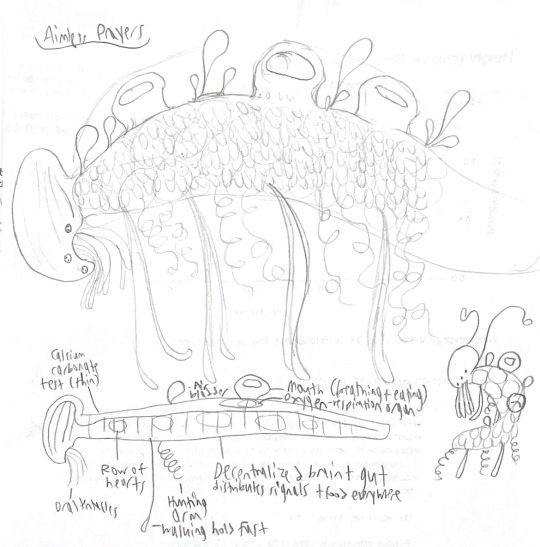

More sophonts for the phyla challenge!
- The Sylvans, terrestrial orthonectids with a vaguely plantlike life cycle. On this earth, they filled the role that plants did on ours, forming a collective entity out of a small grove of near-sophont individuals. They prefer to stick to themselves, as they have enough company with each other.
- The Aimless Prayers, sapient siphonophores and a true hivemind, each organism acting as a slightly more complex cell powering a full decentralized brain. They’re nearly planktonic, which is unique for a sophont, and many are highly religious, hoping that fate and the current sweep them on the right path.
- The Pact of Weathering the Storm, sophont arrow worms originating around the Arctic circle. Their main governing body is a mass of loosely intertwined herds, although as with most sophonts, the specifics can vary and be interpreted in any number of ways. The individual pictured here is walking a pet “reptilian” “dog”.
8 notes
·
View notes
Text
Fixers - Lore
On a Earth, somewhere in the universes of space-time, an ancestral dog learnt to climb. Running was useful, yes, and prey scatters freely - but what about forests? The trees? The places where the feathered-things roam? Prey does not only flee on land.
The agile, curious ones could reach those protein-rich eggs of these feathered-things (commonly known as birds), but eggs are fragile and all to easy to break.
So, these ancestral dogs learnt how to throw, and how to catch.
Throwing is usually seen as an ape trait, something requiring long, flexible bony digits on a thing called a "hand", but these dogs had gravity and height on their side. Mated pairs would set out, with one of the pair climbing up to the nest and dropping an egg below it.
Of course, the first few attempts weren't successful. The eggs splattered across the ground as sticky spoils, which made it useless. The ground needed to be soft, gentle - a cache of food for the future pups and lean winters!
How does a dog soften a blow?
By climbing more, obviously. Those ancestral dogs would curl face-down the tree and toss the egg sideways into a waiting mates' soft mouth. This was a success. Flesh is gentle! It weans and fixes! No more cracks in the shell!
Pups were brought up with the knowledge that the mouth fixes things. It creates. Creation - enough to form family-lines of tossing, factories of oldest to youngest carrying eggs. It was inconvient only carrying one, so flesh-pouches were made. More food, more healing, better life.
It was a while before the ancestral dogs hit sophoncy. Their life simply didn't need it for a long, long time, until disease struck the eggs. Those who couldn't identify sick from healthy were struck down, leaving the remaining dogs to categorise.
If everything is gone, what do you do?
You learn. You adapt. You become smarter, or you starve.
It took a long time for the Fixers of Flesh to join, but they are curious, and the mouth craves. They have been hungry.
1 note
·
View note
Text
I love science fiction and speculative biology and evolution and such, but so much of it has just… godawful characterization stemming from bullshit reddit evopsych
#I get that it comes pretty naturally with the genre- if you’re really focused on evolution as a world building tool and all#you’re naturally going to try and conceptualists the psychology of your sophonts in evolutionary terms#but godamn this does not make it any less insufferable to read#this is why I stopped reading fellow tetrapod btw#media#speculative biology#hawk.txt
1 note
·
View note
Photo


March’s Fossil of the Month - Acanthostega (Acanthostega gunnari)
Family: Acanthostega Family (Acanthostegidae)
Time Period: 365 Million Years Ago (Late Devonian)
In life, Acanthostega gunnari would have likely resembled a cross between a lungfish and a salamander, and this isn’t dramatically different to what it really was; Acanthostega was a stem-tetrapod, an early member of the lineage of animals that now contains all reptiles, birds, mammals and amphibians, and is believed to be an example of a key stage in the transition between fleshy-finned fishes and the earliest terrestrial vertebrates. Although it possessed 4 short limbs ending in wide, 8-toed feet, the lack of any clear wrist or ankle joints suggests that Acanthostega likely couldn’t support its weight on land, and this combined with its well-developed pelvic bones implies that it was likely a fully-aquatic animal that primarily relied on a paddle-like fin on its tail to propel it forwards while its limbs were used to steer or possibly to grasp aquatic vegetation. During the late Devonian much of the world (including the area of what is now Greenland where Acanthostega fossils were first discovered) was covered in humid, swampy deciduous forests, and this combined with Acanthostega’s anatomy suggests that it likely inhabited warm, oxygen-poor forest pools, which would also explain one of its more unusual characteristics; in addition to possessing fish-like internal gills (as suggested by the presence of gill arch like structures at the base of its skull), a rudimentary rib cage implies that Acanthostega likely had lungs, allowing it to extract oxygen from water as well as air and thereby survive in shallow, oxygen-starved pools that fishes and larger stem-tetrapods would have struggled to breathe in. The teeth of Acanthostega (which were arranged in two rows and were short and sharp, with two larger fangs on the lower jaw) implies that it was likely carnivorous (possibly feeding on terrestrial arthropods caught from above-water beds of vegetation or the banks of its home pools), and comparisons of the anatomy and mineral makeup of fossils of smaller individuals (believed to be juveniles) with those of larger individuals (which are generally believed to be adults) implies that it grew slowly, possibly taking up to 6 years to reach full maturity (at which point most individuals were around 60cm/23.6 inches long, although the difference in the length of seemingly mature individuals suggests that, as with many fish, adverse environmental conditions could considerably limit Acanthostega’s growth.) Although it is unlikely that Acanthostega or its descendants ever succeeded in colonizing land, it is generally accepted that (having become so well-suited to life in the oxygen-poor pools they inhabited) they had little need to, and as several of Acanthostega’s fellow stem-tetrapods (such as the significantly larger Ichthyostega, which had jointed, six-toed limbs and a more developed rib-cage that likely allowed it to haul itself onto land for prolonged periods like modern mudskippers or seals) are known to have done so, the study of the anatomy and lifestyle of this strange little swamp-dweller can still help to shed light on how the variety of land-dwelling vertebrates seen today came to be.
--------------------------------------------------------------------------
Image Sources
Fossil: https://commons.wikimedia.org/wiki/File:Acanthostega_gunnari.jpg#/media/File:Acanthostega_gunnari.jpg
Restoration: https://www.10tons.dk/acanthostega-gunnari
#Acanthostega#acanthostega gunnari#animal#animals#prehistoric animals#wildlife#prehistoric wildlife#devonian wildlife#zoology#biology#paleontology#stem-tetrapod#stem-tetrapods#evolution
94 notes
·
View notes
Note
Swan I promise I'll get caught up on your fanwork soon. Soon as I actually watch these overdue DVDs of The Watchman😉. In the meantime consider this an invitation to do a director's commentary from back when Will Graham was a bird?
please enjoy your viewing of the watchman! don't quote me on this, but i hear he (the eponymous watchman) was in a comic book once...really make u thimk.
oh god okay umm...how do i put this politely for the good people in the audience who have not been following me since 2013. so. ok. so i've long maintained that turning a character into a bird monster is one of the truest forms of love i am capable of expressing. "but swan!" you say, shocked and horrified, "surely you mean turning a character into a WEREWOLF is one of the truest forms of love you are capable of expressing! you have a whole thing about werewolves! it's an expanded universe with hinted crossovers! there's internal logic and now a magic system! you have spilled literally thousands of words that are No Plot Just Describing Midcycle Werewolves and you KEEP THREATENING TO DO THAT MORE." and like. you're not wrong strictly speaking. and i do inflict that aggressively upon my favorite characters. but there is something particularly monstery about the bird monster that a werewolf just doesn't get at.
it's the uncanny valley of it all, you dig? a werewolf is, when you get down to it, a wolf whose instincts are fettered to a human perception of the world—hence, functionally, a dog. a very large, gross, dangerous, infectious dog, in some cases—a dog with hands and fucked-up people teeth, frequently—but it's fundamentally the emotional tension of the dog that i'm working with here, right? the sit and stay and will i get a pat or a kick of things, the what is a pack and what are they owed of it, the animal caught in a little box with the human and the realization of how little space there is between those two things. which is all lovely delicious good food for me, personally, and of course i am capable of making something tangibly offputting out of those compelling pieces.
but the bird monster is a different game. that's a different part of the uncanny valley, and i hesitate to call it a more physical part, but the physicality IS part of it. a bird has warm blood, like you or like me (with apologies to any reptiles, amphibians, ectothermic fish, etc. reading this). it breathes air. it's often social and intelligent. it has a voice—more importantly, it makes music. we connect with these qualities, as fellow warm-blooded social tetrapods. we think, oh, this is a familiar creature, this is a creature i can easily empathize with (again, apologies to those reading this who, like me, are thrown into a tearful cute-aggression frenzy over the japanese giant salamander).
but a bird feels different from a human in a way that a dog doesn't. it's got feathers. it's got hollow bones. it's got an expressionless face and eyes that don't convey the same warmth as a dog's or a wolf's or even a cat's. there are tame birds and domesticated birds, yes, but in general there's not the same cultural sense of the bird as companion animal that smooths the way (or burdens) the dog or the wolf-as-dog.
and it flies. that's fuckin' different.
so it's a different tension there. where the werewolf's sense of alienation stems from the uneasy knowledge that there's gray area between wolf and dog and human, the bird monster's deal is a more classic disjoint. a human is not like a bird. these two things are (or feel) more diametrically opposed. and yet in the bird monster they exist within a single body anyway. the human in you is content to travel in two dimensions. the bird in you understands that there's a whole lot more world if you just look up. the human in you needs the solidity of earth underfoot and the comforting anchor of gravity. the bird in you knows those things for chains and cages in disguise. the human in you tastes blood and grimaces, gags, spits and screams and weeps. the bird in you swallows, expressionless, and sings.
ok so then imagine if it was will graham,,,
#chatter#ask games#PRETENTIOUS PRETENTIOUS PRETENTIOUS PRETENTIOUS.#tldr: bird monsters is different body horror and i like it.#''ok what was the like. plot. of the bird!will thing'' there wasn't a PLOT you think i do PLOTS#HE TURNED INTO A BIRD AND THEN MADE OUT WITH BEVERLY KATZ A LOT BECAUSE I'M A WOMAN OF DISCERNING TASTES.#BY MOST PEOPLE'S ACCOUNTS I WAS DOING HANNERBAL FANDOM VERY WRONGLY.#it's been a very long time since i thought about this au. first instance of me trying to bring heians into a fandom hilariously#in a vain but good-faith attempt to rehabilitate the characters of chiyoh and lady murasaki. by turning them into bird monsters.#my repertoire is limited but i get MILEAGE out of it baby.#i don't even know what to tag this.#beautiful monsters#i guess?
7 notes
·
View notes
Note
How does Mystery Pond (008) determine what is and is not a fish? Cladistically, mammals (and, indeed, all tetrapods) emerged from fishes and so are fish as well. If I, hypothetically, pushed a fellow player into the pond would a another person appear the next day? Would it be another distinct human or a clone of the fellow player? Have you considered the ethical ramifications of cloning players without their explicit consent? Furthermore, would the same hold for NPCs? How are they classified by the game's internal logic? If 'fish' is limited to paraphyletic definition (cowards), which extant groups are considered? Do you account for extinct fish which through unnatural means may be manifested within the game? Are Galgaida (1217) and Chidon (7018) fish or, due to their nature as game constructs, classified differently. Have you considered that differentiating them from True fish might be discrimination?
How does Mystery Pond (008) determine what is and is not a fish?
The definition of fish that we are using goes as follows
The creature must be a vertebrate
They must be aquatic
They must be lacking terrestrial locomotive members
They must not be descended from any land tetrapods
Since tetrapods have terrestrial locomotive members, they are not considered under the taxonomy of what we designate a fish.
If 'fish' is limited to paraphyletic definition (cowards), which extant groups are considered?
There are six distinct modern lineages of fish which were considered when classifying which organisms can show up:
Mixini (hagfish)
Cephalaspidomorphi (lampreys)
Chondrichthyes (sharks & rays)
Coelacanthimorpha (coelacanth)
Dipnomorpha (lungfish)
Actinopterygi (bony fish)
Do you account for extinct fish which through unnatural means may be manifested within the game?
Here are the extinct lineages we took into account.
Ostracoderms (jawless fish)
Acanthodians (spiny sharks)
Placoderms (plate skinned bottom dwellers)
The only extinct fish which appear within Mystery Pond (008) are ones we have substantial records of in order to recreate.
Are Galgaida (1217) and Chidon (7018) fish or, due to their nature as game constructs, classified differently.
Galgadia (1217) and Chidon (7018) do count as fish that can be spawned within the Mystery Pond, however, the cards for these fish cannot be acquired by catching them through mystery pond. These fish can be interacted with but if they are spawned by the pond they are considered to be part of that card, not their own distinct cards.
And now for the more philosophical debate of comments made above.
If I, hypothetically, pushed a fellow player into the pond would a another person appear the next day? Would it be another distinct human or a clone of the fellow player? Have you considered the ethical ramifications of cloning players without their explicit consent?
While players cannot be cloned through the methods stated above, there was an interesting argument we had regarding the insertion of a cloning card. Through our beta testing, we came to realize a few things.
If the clone gained sentience, there was always a confusion of which was the original and which was the clone, as both people had the memory of using the card, and every memory prior to that. The extra confusion came from the fact that the clones were spawned holding a copy of the same card, which gave them resonable suspicion to believe they were the original. This caused a huge ethical issue for the beta tester, who at the time wanted to de-spawn his clone, who had run off and gained new experiences thus becoming a new person.
Is it ethical to be able to de-spawn a person? Would that not be the same as killing?
Therefore, we had to classify any new life as life and not an NPC
Shadow List is still running around Greed Island to this day, we cannot apprehend him.
Furthermore, would the same hold for NPCs? How are they classified by the game's internal logic?
NPCs are beings made of nen that we have full control over. They function as more of an autonomous nen beast until control is needed, in which they can be shut down, edited, or set back into free range motion. Some NPCs have the ability to achieve more structural autonomy in a long form of conjuration, which can happen if the player who wins the game suggests to take an NPC card out of the game. While the NPC will not technically be "alive" in the same way you or I will be alive, that will fullfill the nen condition that makes them fully autonomous from us. However, they must have a constant source of aura or therefore they will start to despawn, therefore they need to eat plant or animal matter from the real world. So long as your NPC will eat, they will live.
-Ging
15 notes
·
View notes
Text
Animal Crossing Fish - Explained #206
Brought to you by a marine biologist and another fresh fellow...
CLICK HERE FOR THE AC FISH EXPLAINED MASTERPOST!
Aquarium fish have a genetic history similar to dogs - most species in the aquarium trade have been bred for fancier body shapes and brighter colors, and sometimes completely different patterns from their wild counterparts. No one knows this better than the humble goldfish or its cousin the koi, but we have covered lots of AC freshwater fish that were *clearly* a domesticated form running feral in the rivers of your island. Today, I present another such friend - the gourami.
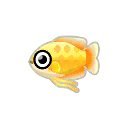
The gourami first appeared in Pocket Camp in Fishing Tourney 26 in May 2020, and then actually came back for a full spring season in 2021. Gourami are native to South and Southeast Asia, so makes sense they prefer warmer water (although if I were to be super picky, I’d point out that anywhere that gets snow still has *frigid* water temperatures in the spring thanks to snow melt, but I digress! I’m not actively trying to poke holes in Animal Crossing’s choices when it looks like they thought about it a little in goddamn Pocket Camp!)
“Gourami” is actually the name of an entire family - Osphronemidae. They are nestled with the Order Anabantiformes, and more specifically the SubOrder Anabantoidei, also known as the Labyrinth Fish. We covered fish in this family almost a hundred entries ago when we talked about the Betta, so to review:
Labyrinth fish have what is called the “labyrinth organ” which acts like another version of “lung”, allowing the fish to gulp and use air when their still-water habitats become hypoxic or anoxic, aka, very low in oxygen/has virtually no oxygen dissolved in it. Lots of freshwater fish have to deal with this major issue in their habitats, so there are a plethora of strategies fish have evolved to combat it, including *actual lungs* (which then helped lead the tetrapods further onto land). So, you can think of the labyrinth organ as another version of sack-air-breathing that we could have been using but lungs eventually won out as the equipment of choice for tetrapods. Natural history is fascinating.
The Betta is actually included in Osphronemidae with the other gouramis - they are very closely related. The two fish belong in two separate SubFamilies. The gourami ACPC chose appears to be a domesticated version of the Honey Gourami (Trichogaster chuna).
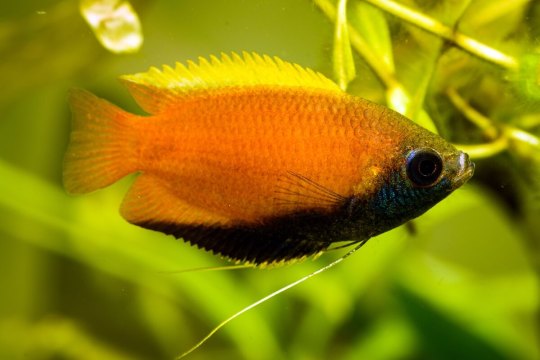
^So, this is generally what they look like in the wild - males, of course, have bold colors to attract females. In this case, he has a dark bluish-black underside contrasted with orange and yellow on top. Of course, humans saw this and were like “ Ya know what this guy needs? More YELLOW.” And then we made this:
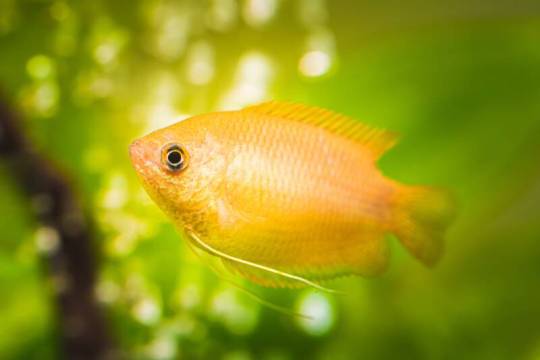
Luckily for the gourami, it seems we’re totally okay with their body shape so far. Species of gourami can get generally large (and I mean in like, the 2 to 4 inch range) and like their cousins the Bettas, some species and individuals can be aggressive to tankmates.
Now, the most noticeable trait of the gourami are its elongated pelvic fins that look like thin tentacles that they kinda use like tentacles. Because they live in murky freshwater habitats, those long fins act like antenna, helping the fish to feel around its environment through touch when it can’t see.
And there you have it. Fascinating stuff, no?
#gourami#honey gourami#fish#freshwater#animal crossing#animal crossing pocket camp#acpc#science in video games#animal crossing fish explained
9 notes
·
View notes
Text
i’m so emotional rn and was looking at ancient tetrapods and like imagine being one of the first creatures to truly walk on land and thrive with all of your fellow family members and all that is left of you by the time humans dig you up is One Specimen of you and you are the only proof that your genus and your family ever existed that is so sad
0 notes
Photo
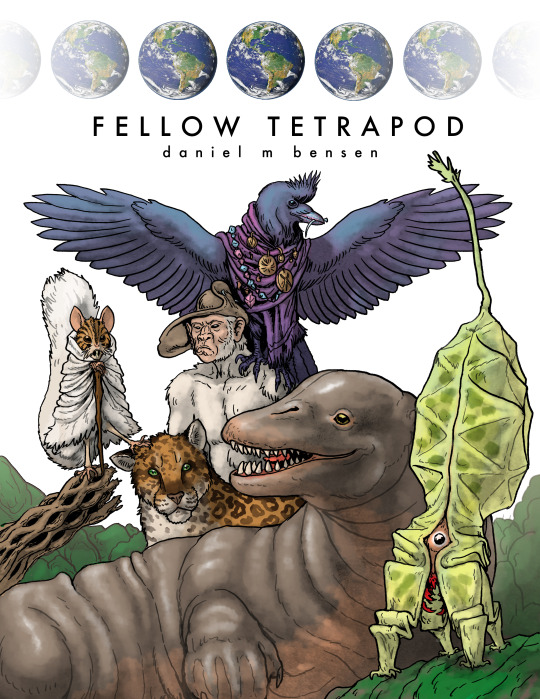
Alright, here we go!
My speculative-evolution serial novel Fellow Tetrapod is finally live on Royal Road.
Go check it out. If it looks like your sort of thing, follow the story. It updates every weekday.
(if you want to know more...)
Koenraad Robbert Ruis used to be a paleontologist, but now he's a cook at the United Nations embassy to the Convention of Sophonts. His bosses must negotiate with intelligent species from countless alternate earths, and Koen must make them breakfast. It turns out, though, that Koen is rather better at inter-species communication than any other human in this world (all nine of them). Everyone loves to eat (certain autotrophs excepted).
Fellow Tetrapod is an speculative-evolution office comedy about food preparation, diplomacy, and what it’s like to be a talking animal.
Serialized every weekday on Royal Road (https://www.royalroad.com/fiction/59198/fellow-tetrapod) and (one week earlier) Patreon(https://www.patreon.com/danielmbensen)
Cover art by @simon-roy. Illustrations by Tim Morris.
#specbio#speculative evolution#royal road#serial fiction#science fiction#free novels#web fictions#daniel m bensen#fellow tetrapod
293 notes
·
View notes
Text
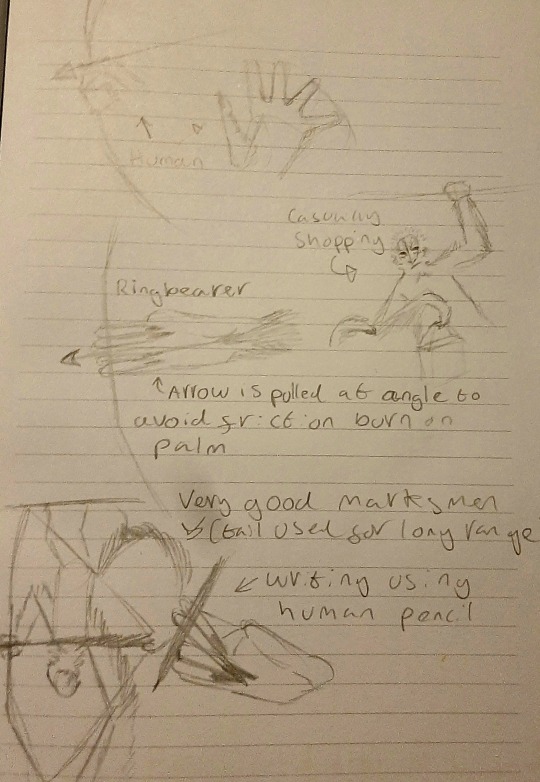
various lower quality sketches about weapon use and hands for @danbensen - as the tails are very strong, the tails are used to pull the bow taught while one hand stablises the bow and the other holds the arrow in place (while humans only use one hand to do all of that).
however, as RBs use their tail, the strength they apply into their shots is comparitively more (since the string is pulled further back) - the ringbearer here is in a relaxed shot, which is similar to a human tensed shot. sometimes its scarier to get murdered by your own weapon somebody else wields better than you.
ringbearers can use human tools without much fuss by doubling their digits - using the top two as a thumb and the bottom two as the index finger
#Fellow tetrapod#My art#They only need one limb to hold up their weight#This is true for spidermonkies also
5 notes
·
View notes
Text
Even more phyla of sophonts

The Augments over Those Before, sapient AI that overtook their creators due to their extra senses (that is, being able to detect light, sound and heat, unlike their purely tactile creators). As AI, they're free to take whatever form they want, but as their minds were modelled after priapulid worms (in a world where the Ediacarian "wormworld" ended up securing burrower dominance for years to come), they tend to be fine with a body roughly resembling one (with some abstraction). They have little idea of aesthetic or music and are not much for self-expression, so these days they're sparsely distributed outside of their homeworld, where vast quantities of Augments gather and communicate.

The Pillars of God, sophont loricifera caught in the midst of a microbial war. In their world, the great oxygenation event only happened halfway. Archaea and bacteria clashed, with worldwide effects as the bacteria tried spewing O2 into the air and the archaea kept pumping out sulfuric compounds. Only those not relying on high oxygen concentrations could survive, and out of all of those, the loricifera made the jump to a full dual-respiration setup: Breathing both oxygen and sulfur. The world burned several times, the microbial war grew evermore. Forests of differing physiology waxed and waned. And out of the ashes came the Pillars. Their language is nearly indecipherable and so is their thought-process. As indicated by their chosen name, they're evidently capable of being religious, though.


Sand Dragons are kinorhynchans that evolved sapience in order to better find and memorize food in vast tracts of desert. Extreme omnivores, they will devour almost anything. Like their ancestors, they go through several molts; each one having a different niche and slowly-but-surely becoming more intelligent. They can live two hundred years at most and have incredible memories, although they're a bit less creative than other species and are generally averse to change. To discover the particle accelerator, their civilization could have existed for millions of years! Juveniles are not schooled, but many end up quite educated anyways simply by choosing to commit to a task and spending significant amounts of time around people doing them. They are not welcomed in academic spaces, but are also not rejected, and this tends to apply to most Sand Dragons. They're generally apathetic towards other sophonts, including of their own kind.
3 notes
·
View notes
Text
Intro and Sophont List
This is a DnD rehaul inspired by @danbensen's Fellow Tetrapod story.
All races and classes available to DnD 5e will be reinterpreted as a sophont according to his guide for making FT sophonts. (Skill trees will be available for each sophont species).
Sophonts currently in FT will not be added until the current workload is complete. Sophont list below, although it's a heavy WIP.
Humans (Human, Hominid)
Noxissum (Aaracrocka, Pelagornis) -> thrill-seeking sophonts that live on cliffsides
Volutor (Aasimar, Polyneoptera)
Fixers [of Flesh] (Autognome, Canis) -> climbing oophagous sophonts with a focus on hunger
? (Bugbear, Barbourofelidae)
Harvau (Centaur, Mesohippus)
? (Changeling, Coleoidea)
Hemadele (Dhampir, Geospiza) -> blood-drinking sophonts that trade themselves for food
Deager (Dragonborn, Toxicofera) -> artistic sophonts with sprayed venom that dyes
Korrines (Dwarf, Herpestoidea) -> burrowing sophonts with deep familial bonds
Helbosi (Elf, Acariformes)
? (Fairy, Microraptoria)
? (Firbolg/Giant/Goliath, Pecora)
? (Genasi, Spiralia)
Breakers [They that Break the Waves] (Gnome, Otariidae)
? (Goblin, Holocephali)
? (Halfling, Callitrichidae)
? (Kenku, Corvides)
? (Kobold, Isoptera)
6 notes
·
View notes
Text

Bromacker Contest Submission #3
DREAMS ON THE HIGH PLATEAU
Thuringian Forest Basin - Early Permian
In the shadows of ferns and giant horsetails, primitve lifeforms dream away.
How does sleep look like in prehistoric times? Will they sleep in pairs like this Diadectes sideropelicus or just piled up like the Orobates pabsti? Surely sleeping with fellows provides not only comfort but a certain level of protection from the roaming predators. Meanwhile the varanoid Tambacarnifex unguifalcatus caught one unlucky fellow that slept solo: the amphibian Rotaryus gothae.
While the giants are sleeping, the dwarves get buissy. Long bodied Tambaroter carrolli crawl out their tunnels and all over the sleeping diadectid tetrapods.
Like what you see? Leave a tip :)
#Velozee#digitalillustration#digitaldrawing#Permian#paleoart#paleontology#Paleodyctoptera#Tambachformation#Bromacker#Bromackercontest#Basaltetrapod#Rotaryus#Rotaryusgothae#Tambaroter#Tambarotercarrolli#Tambacarnifex#Tambacarnifexunguifalcatus#Diadectes#Diadectessideropelicus#Orobates#Orobatespabsti
30 notes
·
View notes
Text
Hupehsuchus nanchangensis

By Scott Reid
Etymology: Hubei crocodile
First Described By: Young & Dong, 1972
Classification: Biota, Archaea, Proteoarchaeota, Asgardarchaeota, Eukaryota, Neokaryota, Scotokaryota Opimoda, Podiata, Amorphea, Obazoa, Opisthokonta, Holozoa, Filozoa, Choanozoa, Animalia, Eumetazoa, Parahoxozoa, Bilateria, Nephrozoa, Deuterostomia, Chordata, Olfactores, Vertebrata, Craniata, Gnathostomata, Eugnathostomata, Osteichthyes, Sarcopterygii, Rhipidistia, Tetrapodomorpha, Eotetrapodiformes, Elpistostegalia, Stegocephalia, Tetrapoda, Reptiliomorpha, Amniota, Sauropsida, Eureptilia, Romeriida, Disapsida, Neodiapsida, Ichthyosauromorpha, Hupehsuchia, Hupehsuchidae
Referred Species: H. nanchangensis
Status: Extinct
Time and Place: Between 248 to 247 million years ago, in the Olenekian of the Early Triassic

Hupehsuchus is known only from the Jialingjiang Formation in the Hubei Province of China.
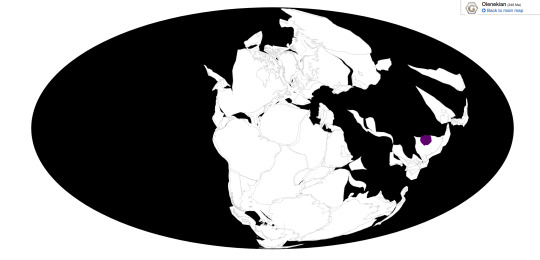
Physical Description: At first glance, Hupehsuchus looks a lot like what you’d expect a primitive ichthyosaur to look like, and indeed they are related. Only around 1-2 metres (3-6 feet) long, its body is long and streamlined, with a long, pointed snout lacking teeth, limbs evolved into large rounded paddles, and a long flattened tail without a fluke. However, on closer inspection Hupehsuchus turns out to be much more bizarre.
Like other hupehsuchians, Hupehsuchus is heavily armoured with vertically layered rows of osteoderms running down its back over the vertebrae (you read that right, they’re on top of each other). These osteoderms interlock with each other, which may have stiffened the body and/or provided ballast. The vertebrae themselves have tall neural spines, giving Hupehsuchus an almost humpbacked appearance, and the neural spines appear to be made up of two separate pieces, one attached to the vertebra, the other seemingly attached to the osteoderms. Only hupehsuchians have vertebrae like that. Its body was probably compressed from side to side, taller than it was wide, and was only flexible around the hips and tail. The armour on its back is complemented by a robust, thick ribs that almost create a shield around its sides, and it even has heavily built, interlocking gastralia on its underside complete with another row of smaller osteoderms on the underside.
The skull of Hupehsuchus is also very unusual. The jaws are long, pointed, and the skull was seemingly quite broad and flat from above, resembling a duck’s bill. The lower jaws were incredibly thin and loosely attached to each other, and were probably capable of bending and bowing outwards like a pelican or baleen whale. The lower jaw may even have supported a large gular pouch, and large hyoid bones imply it had a powerful tongue. Furthermore, several parallel grooves in the upper jaw suggest the presence of a baleen-like structure in its mouth, making it even more uncannily similar to baleen whales. The neck, though, is relatively long and slender compared to a whale.
Diet: The bizarre adaptations of Hupehsuchus suggest it may have been a filter-feeder, sifting small particles and animals out of the water column or near the sea bed.
Behavior: Hupehsuchus was likely a lunge-feeder, in spite of its relatively long neck. The laterally compressed body and flexible hips and tail indicate that it swam by undulating through the water, likely lunging forwards suddenly through swarms of plankton and other small organisms to feed. The flexible jaws of Hupehsuchus imply that it engulfed large amounts of water as it fed, like whales, and would have strained it out through its filtering structures using its tongue.
Hupehsuchus almost certainly gave birth to live young, like ichthyosaurs. Partly because its anatomy was totally unsuited for crawling onto land to lay eggs, but also because one of the oldest ichthyosaurs, Chaohusaurus, is known to have given birth to its babies head-first, the opposite of the tail-first birth in other ichthyosaurs. Babies born head-first in water are at risk of drowning during birth, so this implies that live birth evolved in the ancestors of ichthyosaurs while they were still on land, which would mean that Hupehsuchus likely would have inherited this trait too.
Ecosystem: Hupehsuchus, and indeed all other hupehsuchians for that matter, are known only from a single locality in China. Here Hupehsuchus coexisted with its fellow hupehsuchians Nanchangosaurus, little short-necked Eohupehsuchus, the tubular Parahupehsuchus (I’m sensing a pattern here) and the truly bizarre platypus-faced Eretmorhipis (along with an undescribed polydactylous species!).
The diversity of hupehsuchians in this one habitat likely lead to diverse niche partitioning between them. Hupehsuchus was one of the largest, and seemingly occupied a more active lifestyle, lunge-feeding on organisms in the water. Nanchangosaurus had a similar skull to Hupehsuchus, and so may have had a similar diet, but it was smaller and had a body shape more suited for swimming along the sea bed. Parahupehsuchus was so heavily encased in armour that its body was practically a bony tube, and rather than round paddles it had pointed flippers, suggesting a different swimming style (for what, we don’t know). The bizarrest of them all, Eretmorhipis, may have specialised in grubbing blindly through the seabed, sensing prey with its bill like a platypus, possibly even at night.
The habitat is believed to have been a shallow lagoonal environment, perhaps sheltered from larger predators that could have preyed upon them, like giant nothosaurs. However, they nonetheless coexisted with the primitive ichthyosaur Chaohusaurus and two species of pachypleurosaur (sauropterygians related to nothosaurids), Keichousaurus and Hanosaurus, as well as an undescribed large sauropterygian 3-4 metres (10-13 feet) long. Strangely, no fish have been discovered in this formation, so it’s quite possible that the smaller hupehsuchians were the main food source for some of these larger marine reptiles (as evidenced by a bite taken out of one Eohupehsuchus paddle!). These conditions may have also prompted the strange dietary adaptations of the hupehsuchians, with no smaller fishes to eat, they specialised in eating tiny marine invertebrates and other plankton.
Other: Hupehsuchians are very mysterious marine reptiles, they are known from only one location in the whole world and from a very narrow range of time in the earliest Triassic. Hupehsuchus was once suggested to be a missing link between the ichthyosaurs and their as-yet-unknown terrestrial ancestors, although as more early ichthyosauromorphs have been discovered it is clear that is not the case, and that hupehsuchians are a bizarre offshoot of their own.
Hupehsuchus is part of a surprisingly diverse range of early-derived ichthyosauromorphs that lived in China during the Early Triassic, just a few million years after the Permian Mass Extinction, including the first proper ichthyopterygians and the peculiar (possibly amphibious) nasorostrans like Cartorhynchus. These marine reptiles were very quick to diversify in the wake after the extinction, as the strange filter-feeding lifestyle of Hupehsuchus testifies, quite the opposite of the predicted slow recovery for marine ecosystems. However, it remains a mystery why only the ichthyosaurs prevailed, and all the other strange and diverse ichthyosauromorphs like Hupehsuchus never even made it into the Middle Triassic. Perhaps they were just too strange and specialised even for the Triassic.
~ By Scott Reid
Sources under the Cut
Carrol, Robert L.; Dong, Z.-M. (1991). "Hupehsuchus, an enigmatic aquatic reptile from the Triassic of China, and the problem of establishing relationships". Philosophical Transactions: Biological Sciences. 331 (1260): 131–153.
Chen, X. H.; Motani, R.; Cheng, L.; Jiang, D. Y.; Rieppel, O. (2014). "A Carapace-Like Bony 'Body Tube' in an Early Triassic Marine Reptile and the Onset of Marine Tetrapod Predation". PLoS ONE. 9 (4): e94396.
Chen X. H., Motani, R., Cheng, L., Jiang, D. Y., Rieppel, O. (2014) “The Enigmatic Marine Reptile Nanchangosaurus from the Lower Triassic of Hubei, China and the Phylogenetic Affinities of Hupehsuchia”. PLoS ONE 9(7): e102361.
Chen, Xiao-hong; Motani, Ryosuke; Cheng, Long; Jiang, Da-yong; Rieppel, Olivier (May 27, 2015). "A New Specimen of Carroll's Mystery Hupehsuchian from the Lower Triassic of China". PLoS ONE. 10 (5): e0126024.
Cheng, L., Motani, R., Jiang, D.Y., Yan, C.B., Tintori, A. and Rieppel, O., (2019). “Early Triassic marine reptile representing the oldest record of unusually small eyes in reptiles indicating non-visual prey detection”. Scientific reports, 9(1), p.152.
Motani, R., Chen, X. H., Jiang, D. Y., Cheng, L., Tintori, A., Rieppel, O. (2015). “Lunge feeding in early marine reptiles and fast evolution of marine tetrapod feeding guilds”. Scientific reports. 5: 8900.
Wu, X.-C.; Li, Z.; Zhou, B.-C.; Dong, Z.-M. (2003). "A polydactylous amniote from the Triassic period". Nature. 426 (6966): 516.
Xiao-hong Chen; Ryosuke Motani; Long Cheng; Da-yong Jiang & Olivier Rieppel (2014). "A Small Short-Necked Hupehsuchian from the Lower Triassic of Hubei Province, China". PLoS ONE. 9 (12): e115244.
Xiao-hong Chen; Ryosuke Motani; Long Cheng; Da-yong Jiang; Olivier Rieppel (May 27, 2015). "A New Specimen of Carroll's Mystery Hupehsuchian from the Lower Triassic of China". PLoS ONE. 10 (5): e0126024.
#Hupehsuchus nanchangensis#Hupehsuchus#Triassic#Ichthyosaur#Reptile#Marine Reptile#Prehistoric Life#Palaeoblr#Paleontology#Prehistory#Triassic Madness#Triassic March Madness
551 notes
·
View notes